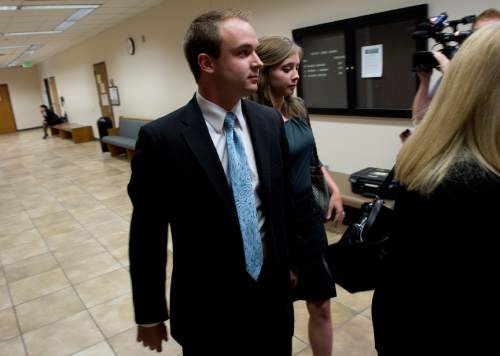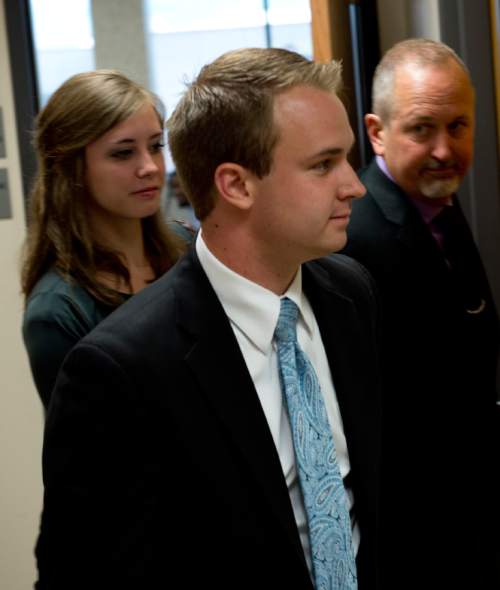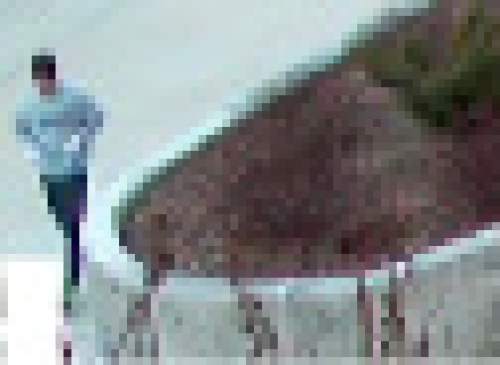This is an archived article that was published on sltrib.com in 2014, and information in the article may be outdated. It is provided only for personal research purposes and may not be reprinted.
Provo • A judge on Thursday decided the suspect in the "BYU Groper" case should stand trial, despite defense arguments that witnesses were "tainted" by suggestion when they identified 23-year-old Nathan Fletcher as the jogger who allegedly assaulted two of 16 women who reported attacks on and near campus earlier this year.
Several of Fletcher's former track teammates at Brigham Young University testified that they recognized his gait and his build in surveillance footage police showed to them. But defense attorney John Allan argued those identifications were invalid because they occurred in a team-wide meeting, where members were whispering in each others' ear while watching the videos.
"There's no court in the land that would allow a group of individuals to witness a photo lineup and decide who that individual is," Allan told 4th District Judge Roger Griffin. "We have a group of people watching a video; that identification is tainted."
Fletcher's teammates testified that they each identified Fletcher independently as they saw the gait of a jogger filmed in BYU's Smith Fieldhouse on March 15, close to the time a victim said a jogger grabbed her breast.
Although the victim reported her assailant was wearing different clothes than the man filmed in the fieldhouse, investigators said they reviewed all surveillance footage in the area and found only one jogger — the one runner identified as Fletcher.
The video "dropped my gut," said teammate Travis Fuller. "I had an ill feeling, not wanting it to be him. I didn't want to believe it. I was constantly trying to deny it. … It's not the Nathan Fletcher that I know."
But Fuller said he "continued to be just more and more convinced" as he considered the individual quirks in the runner's stride — marks that several teammates said enable them to tell each other apart. They pointed to the twist in the runner's torso, the swing in his arms, the shifts of his head, and where his legs turned in.
"I think when you spend a lot of time running around a person or you see them running often, you're able to recognize a lot of different characteristics of their specific forms," said teammate Ryan Waite.
During practice, Waite said, runners will imitate each other and ask, "Who am I today? Who am I today?"
"We're able to recognize who they're trying to mimic, and they're able to duplicate that form," Wait said.
Allan said he planned to ask the trial judge to throw out the teammates' testimony identifying him, saying they were influenced not only by each other at the meeting but also by investigators telling them the suspect appeared to be a member or former member of the track team.
"It's completely suggestive," Allan said.
Prosecutors disagreed, saying that witnesses identifying a suspect in a moving video, from unprompted recognition, is different from a lineup, where they're shown multiple photos of people and told to select one.
Prosecutors also pointed to the clothing of the jogger in two videos filmed near the scenes of two of the attacks. Investigators found in Fletcher's apartment clothing that resembles both outfits.
"It would be a completely remarkable coincidence that Nathan Fletcher would own the same [articles of clothing] … in both incidents," said assistant Provo City attorney Marcus Draper.
Allan countered that the items — black pants, a grey hoodie, blue shorts and a grey long-sleeved T-shirt — are widespread among joggers, and the video was too grainy to conclusively identify them as articles issued to the track team only.
Fletcher is charged with two class A misdemeanor counts of sexual battery, each carrying a maximum sentence of one year in jail.
He will appear in court again for a scheduling hearing on Oct. 9.









